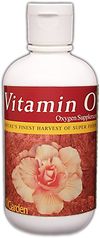|
THERAPEUTIC VITAMIN O
“Vitamin O” Makes A Real Difference In People’s Lives DR. JOHN HEINERMAN REVEALS THE RESULTS
OF A GROUNDBREAKING SIX-MONTH
Stories such as these are not uncommon for Vitamin O users to hear from their friends. This medical anthropologist has been involved with the scientific research of this highly remarkable but very controversial liquid product for several years now. “Vitamin O is a special supplemented oxygen taken in liquid form and produced through electrical-activation with a saline solution from the ocean.” Electrical activation knocks off the sodium molecules and substitutes oxygen in their place. But finding that elemental gas in the product has, until now, proven quite challenging. “There is no special equipment designed to measure oxygen over 40 parts per million,” he said. Early efforts to detect for the presence of elemental oxygen failed in large part for this very reason. Yet the companies involved in the product’s manufacture and distribution knew all along that it was there from the huge amount of anecdotal evidence supplied to them by more than half-a-million users of “Vitamin O”. A proposal was made to both companies for funding a study that would prove once and for all whether or not this unique supplement actually contained elemental oxygen. Human volunteers would be randomly selected and given the product or a substitute. Their blood gases would be closely monitored through periodic sampling made by syringe withdrawals from radial artery wrist sites. The samples would then be iced and promptly transported to the nearest hospital pulmonary lab where sophisticated blood gas machines could then thoroughly test the blood for the presence of added oxygen. A costly six-month study involving 60 test subjects drawn from small farming communities in North America was inaugurated. To be eligible, the volunteers had to be certifiably anemic. Anemia is a medical condition wherein hemoglobin or red blood cell counts are below norm. As Heinerman explained it: “We chose anemia because it reflects a lack of sufficient oxygen to begin with.” Therefore, so the reasoning went “if we gave them the ‘Vitamin O’, then certainly they would post higher oxygen levels over those getting a suitable placebo.” The 60 subjects were placed in 4 separate categories: two groups of 15 each received the “Vitamin O” with or without a standard iron supplement, whereas the other two groups got the placebo with or without iron. What had started out as a hunch attributed to Heinerman, proved, at last, to be the perfect medium in which to test for the presence or lack of elemental oxygen in “Vitamin O”. The results were astounding! “No one was more surprised than myself,” he said, “when all of the test results were finally compiled.” According to him, those receiving “Vitamin O” in this randomized, double-blinded study, “posted higher increases of arterial blood oxygen” than did those on the sterile saline solution of less than 5%. Also, there were elevated discharges of carbon dioxide waste matter, which, in Heinerman’s opinion, “was another way of proving the presence of elemental oxygen in the test product itself.” Older subjects responded better to “Vitamin O”s presumed therapeutic benefits than younger recipients. And the inclusion of an iron supplement with it indicated “a more helpful role in how ‘Vitamin O’ was utilized by the body,” he noted. There followed “a general stabilization of arterial blood oxygen levels” after “three months of steady supplementation” with “Vitamin O”, Heinerman observed. But this could change, of course, “if daily intake were temporarily discontinued.” Study participants were told to take 15 drops of “Vitamin O” beneath the tongue four times a day to equal a total amount of 60 drops. Heinerman, a highly respected researcher and well-published health writer, with 58 books to his credit in 17 different languages, went to some effort to emphasize the major reason for launching this study in the first place. “We were looking for elemental oxygen in this product. Others before us had tried to find it and couldn’t. We figured that blood would serve as the ideal medium in which to test this product for its presumed oxygen content. We did so, and as the French would say, ‘Voila . . . There it is!” Then straightening himself up in his swivel chair from a previous slouching position, to full form, his voice resonated with unmistakable clarity and force: “Blood gas analyses DO NOT LIE! The two groups taking ‘Vitamin O’ posted higher oxygen content in their arterial blood draws and excreted through respiration more waste carbon dioxide than did the control groups on placebo.” There you have in the man’s own words. So when Robert Castanos, age 42, wrote the company that distributes this product and said he had been experiencing “more energy and pep and endurance in doing things” and becoming less tired than before, it was because of the elemental oxygen present in “Vitamin O”. Glenda Jasper, of an unspecified age, declared in a company newsletter dated January of this year: “My life seemed so bleak (until) I was turned on to ‘Vitamin O’ thought a new friend (who) came into my husband’s life one day . . . Yes, I tried (it) for about 15 days and when I returned back from having another set of blood tests, my oxygen level was normal!” The anecdotal side of the aisle now fully supported and confirmed by the science on the other side. Truly a winning combination for which consumers ultimately benefit the most. And changed this reporter’s initial skepticism into sincere belief!
|
